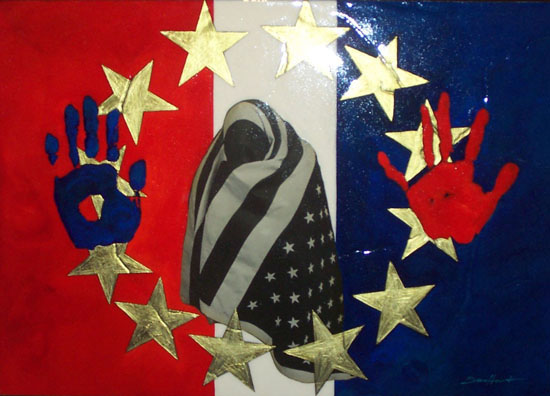
A painting by Keith Brave Heart titled “Living in the arms of youth”
RAPID CITY, SOUTH DAKOTA — Making New Traditions, an exhibit of contemporary indigenous fine art, blends traditional values with modern perspectives. The exhibit focuses on the ways that Native American artists from a variety of Tribal backgrounds view the world. By using a wide variety of fine art media, contemporary artists redefine native art while expressing their own unique ideas and viewpoints about indigenous culture. These young, talented artists show us a new view of the native experience with paintings, drawings and sculptures. In the old tradition of creating art out of what is readily available, some of these artists use what is literally lying around the house. Bed sheets and cola cans, old advertisements and pieces of wild wheat, even old dress patterns are incorporated into thought provoking displays of individual and native identity. A personal statement made by each of the artists, describing their backgrounds, sources of inspiration and feelings about art is displayed along with their artwork. The following are excerpts from these mini-biographies. Henry Payer (Ho Chunk): “My works are about my culture, the Winnebago or Ho Chunk people. Color is a strong element…inspired by the glass trade beads found in traditional plains and woodland beadwork.” Micheal Schweigman (Oglala Lakota): “I walk a fine line between truth and abstraction, giving and taking. Giving an art object that deceives the viewer is a liberating experience; taking from the viewer happens when the bright colors and sugar coats peel away to reveal the truth and abstract thought. I am a trickster; I trick the viewer into believing it’s comedic when it’s serious. What is important is the relationship between the imagery and how it exists with each other in a harmony of disharmony. The harmony is purely in the visual aesthetics of color and mood, the disharmony happens in the juxtaposition of human destruction and nature.” Hoka A. Skenandore (Oneida/Oglala Lakota/Luiseno/Chicano): “What the mass media offers is not popular art, but entertainment which is intended to be consumed like food, forgotten, and replaced by a new dish. An artist is someone who produces things that people don’t need to have but that he – for some reason – thinks it would be a good idea to give them. Finally, the function of art is to disturb. Science reassures.” April Holder (Sac & Fox): “My work is an interpretation of memory. I look for the connections that images retain. My intent is to share elements of my personal memory and to cultivate an interest in historical memory for the viewer, it’s about the relationship between sight, touch and how one’s consciousness is not bound by time.” Marty Two Bulls Jr. (Oglala Lakota): “I work in the 2D and 3D visual realms as well as within music and the written word. I particularly enjoy drawing, filmmaking, stonework, printmaking, woodwork, painting, songwriting, metalwork, writing screenplays and photography, to name but a few. I do not work without first having some emotional/intellectual connection to my work, regardless of the medium; art is first and foremost a matter of expression and expression without heart is trash. The themes for my work reflect my own perspectives on matters ranging from religion to politics to current/historical social injustice.” Keith Brave Heart (Oglala Lakota): “I use the Lakota people and culture, traditional Lakota themes, stories, symbols and designs in a contemporary manner. I want my work to keep the Lakota heritage alive and give aesthetic influence to future generations that they may regain control of (significance) for all themselves as well as all Native people.” Layli Long Soldier (Oglala Lakota): There are times when different mediums provide you with different languages - vocabulary to communicate and we can utilize any of those languages that best suit our message. I grew up playing music I believe sound is a conduit for emotion. At the same time, there are things I can say poetically or in a short story that I cannot access within a song, no matter how melodic, energizing or emotional the song may be. This is how I feel about visual art as well. There is physicality to sculpture or drawing that is difficult to convey in a poem no matter how much the reader is pushed to imagine.” Floyd Nez (Sicangu/Dine’): “My life on the reservation has been my main influence and has shaped a lot of what I paint today the relationship of the community and the individual complimenting each other as we grow together. People I see standing on the corner, out in the country and landscapes (are) a visual language…constantly changing and adapting dramatically.” Making New Traditions is a collaborative project between the Rapid City Arts Council and the Red Cloud Heritage Center at Red Cloud School near the town of Pine Ridge on the Pine Ridge Indian Reservation. The artists whose displays can be seen in the Senator Adelstein and Lynda Clark Gallery at the Dahl Fine Arts Building through September 3, 2011 will greet the public in a reception to be held on June 10 from 5-7 p.m. (Contact Aly Duncan Neely at kestreldancing@yahoo.com)
Join the Conversation